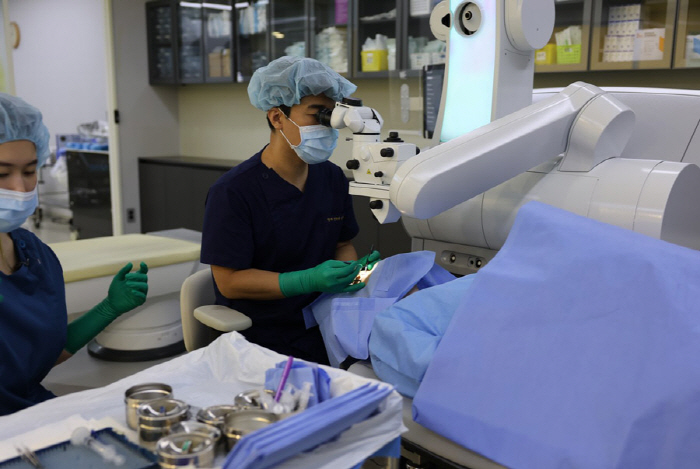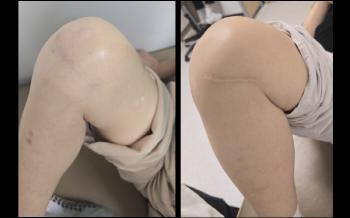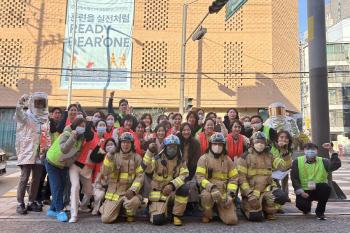I compared the effects of vision correction during the vacation season, smile LASIK, and lens insertion...
|
Eye correction surgery to remove uncomfortable glasses is mainly a method of correcting the refractive index of the cornea with a laser or inserting a special lens suitable for one's own frequency into the eye. Smile LASIK and lens insertion (ICL) are the most recent surgeries. Both methods have excellent safety and vision correction effects and are popularized worldwide.
However, from the perspective of patients undergoing actual surgery, there are still concerns about whether they are really safe, whether their eyes will become more uncomfortable after undergoing surgery, or whether they will regret it. These concerns and anxieties are not just about whether or not vision is restored, but also about the aftereffects or side effects that appear after surgery.
Kim Boo-ki's team at Onnuri Smile Eye in Gangnam analyzed the survey on satisfaction and discomfort after a year of smile surgery and lens insertion, a leading vision correction, and presented it to the American Cataract Refractive Surgery Association (ASCRS) in 2025.
SMILE (Smile), a laser vision correction surgery, uses a femtosecond laser to preserve the corneal surface and correct the refractive power without creating corneal sections. Compared to traditional LASIK and LASEK, it is relatively latest surgery, but it has less corneal damage, no pain, and fast vision recovery, so patients have high preference.
More than 10 million surgeries have been performed worldwide for more than 10 years, and clinical results have been proven through a number of academic papers.
ICL (Impossible Collar Lens) is a method of restoring vision by putting a special lens with excellent biocompatibility according to its frequency in the rear position between the lens and the iris. In particular, it is known that thin corneas, myopia, and astigmatism show better clinical results than other surgeries.
The medical team conducted a survey of a total of 324 patients, including 227 patients with smile surgery and 97 patients with lens insertion surgery (ICL), on the degree of discomfort and persistence of the five major symptoms, including 'disappearance, spread, glare, light spread, and dry eyes after a year of surgery.
The patients ranged from -0.5 to -18.0 diopters, and consisted of patients who met all the surgical criteria such as corneal thickness, eye depth, and stable refractive condition. The average age is 27 years old, all over 19 years old.
As a result of the analysis, overall surgical satisfaction was very high in both groups. 97.4% of patients in the smile surgery group and 99% in the ICL group responded that they were satisfied with the surgery.
However, in terms of discomfort, there was a significant difference between the two surgeries, and the most common discomfort felt by patients was glare and light spreading. Light blurring and glare were more present in ICL surgery patients, and the duration of disappearance of the symptoms was also longer than that of the smile. Dry eye symptoms were more frequently severe in patients with smile surgery, and the duration of disappearance of symptoms was also long. There was no significant difference between the two surgeries in blurring and spreading.
The symptoms of discomfort in the two surgeries naturally improved in most patients over time, and the remaining symptoms were not severe.
This study suggests that both smile and lens insertion surgery are safe and highly satisfactory vision correction methods overall, but that the characteristics and tendency of discomfort that may remain after surgery are different.
In response, Kim Boo-ki, director of Onnuri Smile An in Gangnam, said, `If patients who want to escape from the inconvenience of glasses and contact lenses want to choose the most suitable vision correction method for them, they should not simply focus on corneal thickness or vision levels, but should listen to the full explanation of the symptoms of discomfort that can be expected after surgery and make a careful decision"It is important for medical staff to manage the various symptoms of discomfort that patients feel after surgery to not last long and to help them find stability quickly."
Jeong Young-taek, director of Jeonju Onnuri Eye Hospital, said "One of the important variables in vision correction surgery for the majority of nearsighted patients is astigmatism, and the surgery method may vary accordingly."When correcting myopia with a laser, if astigmatism is present, corneal cutting can increase by 20-30%, so it is essential to check the degree and presence of astigmatism before surgery."
In general, moderate astigmatism can be corrected simultaneously with myopia with smile surgery. However, advanced astigmatism can be difficult to completely correct and its stability is poor in the long run. In this case, the medical team explained that choosing to receive astigmatism correction and lens insertion at the same time without cutting the cornea, or step-by-step surgery to correct myopia with smile LASIK and smile pro after reducing astigmatism first can increase safety and accuracy.
|
This article was translated by Naver AI translator.





